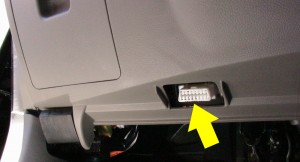The gaugeART CAN OBD Link requires Controller Area Network (CAN) communication at your vehicle’s OBD2 port. This guide outlines how to check for CAN communication to ensure compatibility with the gaugeART CAN OBD Link. Vehicles sold in the USA from 2008 onwards are generally equipped with CAN and compatible with the gaugeART CAN OBD Link. However, many pre-2008 models and vehicles sold outside the USA may also have CAN. If your vehicle falls into these categories, follow these steps to verify CAN communication at the OBD2 port.
Locating the OBD2 Port
The first step in Checking Can At Obd2 Port is to locate the OBD2 diagnostic port. This port is mandated in passenger vehicles and is typically found under the dashboard on the driver’s side. It might be covered by a panel.
Identifying Key Terminals
Next, you’ll need to examine the OBD2 port itself. Refer to a standard OBD2 pinout diagram and locate terminals 6 and 14. These terminals are crucial for CAN communication. Visually inspect the port to confirm if metallic contacts are present in these positions. If metallic contacts are absent in terminals 6 and 14, your vehicle likely doesn’t support CAN communication at the OBD2 port.
Testing for CAN with a Multimeter
If you find metallic contacts at terminals 6 and 14, proceed with a multimeter test. Ensure your vehicle’s ignition is OFF and the key is removed. Set your multimeter to measure resistance (Ohms). Then, place the multimeter probes on terminals 6 and 14. A reading of approximately 60 Ohms (± 2 Ohms) indicates the presence of CAN communication. This confirms compatibility with the gaugeART CAN OBD Link.
Conclusion
Checking for CAN communication at the OBD2 port is a simple process using visual inspection and a multimeter. By following these steps, you can determine if your vehicle supports CAN and is compatible with devices like the gaugeART CAN OBD Link. If you confirm CAN communication, you can proceed with confidence in using your CAN-dependent device. If your test indicates no CAN communication, alternative solutions might be required for your specific vehicle.
